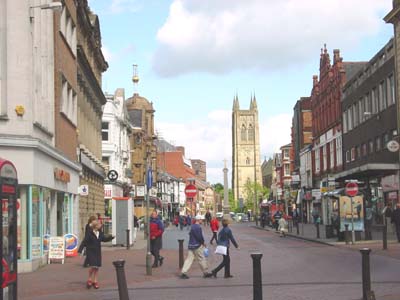 |
The Town of Bolton |
 |
Bolton is located 10 miles north west of Manchester on the fringe of the western slopes of the Pennines. One theory is that its name is derived from its situation in a bowl in the hills, 'bowl town'.
Though whatever the source, its name has caused some confusion over the years. Now known simply as Bolton, it was formerly known as Bolton le Moors. It also seems there is a move afoot to restore this original name. Then with the coming of civil registrations and census, the divisions of Great Bolton and Little Bolton were created, yet in reality, all refer to the same place.
Bolton has had a long and colourful history, there being evidence of early settlement in the area in the form of a stone circle on Turton Heights just above Egerton.
 | |
The exact date of the establishment of a church in the area is unclear, though there is evidence of its existence prior to the Domesday Book. Bolton is one of the original parishes that constitute the Salford Hundred. Also part of the Salford Hundred is the neighbouring parish of Deane which because of its significance, though now part of Bolton, is treated as a parish in its own right.
The town of Bolton was granted a Royal Charter to hold a market in the area around Churchgate in 1251. Bolton also boasts one of the oldest pubs in the country with the Man & Scythe, in existence at the time of the Charter and still in operation today on Churchgate.
Flemish weavers arrived in Bolton in 1335 and probably played a part in the rise of the cotton and weaving trade in Bolton. By the 16th century, Bolton was beginning to become a centre for trade and industry with the emerging cotton industry at its heart. At this time it was entirely a cottage industry. From a religious standpoint, it was becoming a hotbed of Puritanism.
Among the more famous Puritans was George Marsh, a particularly outspoken and militant minister from Deane. At the time of intense Protestant persecution in 1554, he was brought before Sir Roger Barton at Smithills Hall. It was during this interrogation he is reputed to have stamped his foot on the floor and prayed that a mark should be left there to show the injustice of his accusers. His supposed footprint can still be seen at Smithills Hall today, in the passage between the chapel and the dining room. According to legend, this footprint becomes wet with blood every year at the time of his interrogation.
George Marsh was subsequently taken to Chester where he refused all appeals to recant and was put to death by burning.
This Puritan stance also molded Bolton's fate during the Civil War. Bolton was fortified with walls of mud and twice fought off Royalist forces in 1643. By 1644 with the Royalist cause fading, Lathom House, the home of the Earl of Derby, was the one remaining Royalist stronghold in Lancashire. This was besieged by the Parliamentary forces, many of whom came from Bolton. Lathom House was relived by a force led by the King's Nephew, Prince Rupert of the Rhine who came with a force of 12,000 men.
Many of the besiegers retreated to Bolton, followed by Rupert, who attacked on 28 May 1644. The first attack was repulsed, but the second broke through the mud walls and what ensued can only be described as a massacre in which it is thought as many as a 1,000 people may have perished.
The Earl of Derby was held responsible for these events and after spending his final hours in the Man & Scythe, he was beheaded on Churchgate on 15 Oct 1651.
| Bolton le Moors Home & Contents | ©Lancashire OnLine Parish Clerks | Lancashire Home |